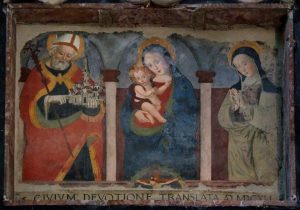Italy is a wounded country. Never, in recent years, the Bel Paese has endured so much tragedy in such a short amount of time. Black-clad still, mourning the almost 300 victims of last August’s quake, Italians woke up a week ago shaking again: “norcini” felt it under their feet and over their heads, the rest of us within their hearts and in their blood.
“Il mostro,” the monster, as people of those unfortunate lands calls the earthquake, struck again, and again it left behind an apocalyptic landscape of desolation, destruction and hopelessness.
No bodies to count, this time, yet the sorrow is raw and you won’t find a person here who manages to speak about the Norcia earthquake without fighting a painful lump down their throat: as nonsensical as it may seem to some, no loss of lives doesn’t mean Italy doesn’t have anything to weep for.
We’re again a country in mourning, but not for people, this time. This time, we mourn stones: stones that stood other earthquakes, wars, floods. Stones that survived centuries and silently witnessed the history of Italy coming into being. Stones that for hundreds and hundreds of years have offered protection and hope, stones millions of hands touched in prayer, stones holding within the essence itself of a people, with all its idiosyncrasies and defects, but also all its immense love of life.
The symbol of it all is the Basilica di San Benedetto, in Norcia, whose body failed under the mortal waves of October’s earthquake. Of its secular beauty, only the façade remains, its delicate rose window opening into the empty nothingness that’s left behind. The Italian Fire Brigade, that many here began calling “angels” because of their continuous, relentless service in central Italy, managed to save a valuable painting from the ruins, but everything else is no more, fallen to the ground with a heavy, dreadful thud, flown to the sky like ashes.
The basilica had been built, tradition tells us, upon the ruins of Saint Benedict’s own home. It took the people of Norcia 200 years, from the 13th to the 15th century, to finish it. With its late Italian gothic façade and belfry, its statues of saint Benedict and Saint Scolastica and its polychrome marbles carvings, the basilica’s exterior was an ode to medieval architecture. Its interior developed along a large single nave and had been delightfully decorated by several artists.
For three times earthquakes brought it to the ground in the 18th century, for three times the people of Norcia built it up again, stronger, better, with more faith. Yet, we’re here today again, just like our forefathers all those centuries ago, sifting through the rubble.
In the very same square, another church dedicated to Santa Maria Argentea collapsed, burying under meters of debris an 18th century organ and, very likely, a precious 13th century wooden crucifix.

Piazza San Benedetto in Norcia is no longer a square, it’s a place for ghosts.
Just like the Basilica and Santa Maria Argentea, hundreds of other artistically relevant buildings have been irremediably compromised by the earthquake, causing an inestimable damage to Italy’s own artistic patrimony.
That made to the country’s heritage and identity is a deep wound, because art to Italy is like the soul to a human being: it’s the essence of the country, its beating heart and historical memory. It’s what all the world envy us and what, in spite of time passing and trends changing, Italy has always excelled at. For centuries, as Johnathan Jones of The Guardian has rightly pointed out, Italy has created beauty off its instability, it being political or geological, shaping the awesome from chaos, the wondrous from violence.
This is why what was lost to the Norcia earthquake is not a loss to Italy only, but to the world: these churches and palaces, with their old stones and marbles spoke to each and every one of us of the immense potential of Mankind and of the beauty of the world. They spoke of spirituality and history, but also of stones, mortar and wood, with which they were built, and of the gritty hands who did it.
They stood, beautiful witnesses to the history of Europe and the world, to that of art and philosophy and architecture. They stood symbol of the Good Man can do.
This is why the whole world, I think, should mourn for what the earthquake stole from Norcia.
If you want to help and support reconstruction, you can do so also through the Deep Roots initiative, endorsed by the monks of the Norcia Monastery of San Benedetto, at www.nursia.org.





























